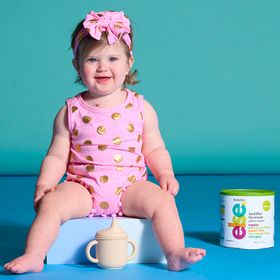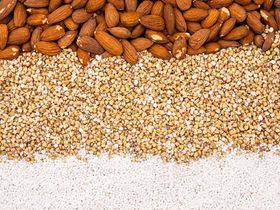Do Babies Need Baby Cereal? A Parent's Guide
Is your baby ready for solids? Understand the role of baby cereal in your baby's dietary development
Updated September 12, 2024

As your baby grows and develops, its nutritional needs evolve. Around the six-month mark, an exciting milestone occurs—it's time to introduce solid foods! Baby cereals have long been a popular choice for first foods, but many parents wonder: Are they really necessary?
This guide will help you navigate the world of baby nutrition and make informed decisions about incorporating cereals into your little one's diet.
» Is your baby ready for solids? Try organic and nutritious baby cereal
The Transition to Solid Foods
Most health organizations, including the American Academy of Pediatrics, recommend introducing solid foods around six months of age. But every baby is unique, and your pediatrician may suggest a different timeline based on your child's individual needs and development.
Signs of Readiness
Look for these signs that your baby might be ready for solid foods:
- Ability to sit up with support
- Good head and neck control
- Showing interest in food when others are eating
- Decreased tongue-thrust reflex (no longer automatically pushing food out of their mouth)
- Doubling of birth weight (typically occurring around 4–6 months)
» Learn more about how to introduce your baby to solids
Why Introduce Solids?
The transition to solid foods is crucial for several reasons:
- Nutritional Variety: Solid foods provide a broader range of nutrients, supplementing breast milk or formula.
- Sensory Exploration: New tastes, textures, and smells help develop your baby's palate and sensory awareness.
- Motor Skill Development: Eating solids improves hand-eye coordination and oral motor skills.
- Digestive System Maturation: Exposure to different foods aids in developing the digestive system.
- Caloric Density: As babies grow, their caloric needs increase rapidly. Solids provide additional calories to support this growth spurt, complementing breast milk or formula nutrition.
» Explore these top tips for transitioning from breastfeeding
Benefits of Baby Cereal as a First Food
Among the various solid food options, baby cereal stands out as an excellent choice for several reasons:
- Iron Fortification: Around six months, babies' iron stores deplete. Iron-fortified cereals can help prevent iron deficiency, supporting brain development, motor skills, immune function, and red blood cell production.
- Nutrient Density: Fortified cereals often contain additional essential nutrients like fiber, B vitamins, protein, zinc, vitamin E, and potassium, which complement breast milk or formula and support healthy growth and development.
- Texture Variation: Parents can easily adjust the consistency of cereal by adding more or less liquid. This gradual texture progression, starting thin and thickening over time, helps babies develop their oral motor skills.
- Swallowing Practice: Cereal's semi-solid nature helps babies learn to move food from the front to the back of the mouth, a crucial skill for preventing choking.
- Familiarity of Taste: When mixed with breast milk or formula, it takes on a familiar taste. This can make the transition to solid foods smoother and more appealing, especially for infants who might be hesitant about new flavors.
» Learn about the benefits of vitamin D and calcium for kids
Potential Drawbacks
While baby cereals offer many benefits, there are some considerations to consider.
1. Processed Nature: Some baby cereals are highly processed and may contain added sugars or preservatives.
- Solution: Look for more natural options that contain whole ingredients and no added sugars. Check the ingredient list and choose cereals with minimal, recognizable ingredients.
- Tip: Consider organic varieties, which are less likely to contain artificial additives.
2. Allergenic Potential: Many common ingredients in baby foods, including cereal grains, dairy, and soy, can be allergenic for some babies.
- Solution: Choose brands that are certified allergen-free or specifically formulated for babies with allergies.
- Tip: Always introduce new foods one at a time and wait a few days before introducing another to identify any potential allergies quickly.
3. Overreliance: Exclusively feeding cereal may limit exposure to various tastes and textures.
- Solution: Cereal should be just one part of a diverse diet. As your baby grows, start including fruits, vegetables, and other foods in their meals.
- Tip: Mix cereal with pureed fruits or vegetables to increase diversity.
4. Dental Health: Letting a baby fall asleep with a bottle of milk mixed with cereal can lead to tooth decay.
- Solution: Avoid putting cereal in bottles unless specifically recommended by your pediatrician. Feed it with a spoon instead.
- Tip: Practice good oral hygiene by gently cleaning your baby's gums after feeding.
» Check out the best baby cereals with no heavy metals
Tips for Introducing Baby Cereal
If you decide to include baby cereal in your child's diet, here are some strategies to make the transition smoother:
- Start slow: Introduce cereal gradually, beginning with a small amount (1–2 teaspoons) once a day.
- Choose single-ingredient cereals initially: This makes identifying any potential allergies or intolerances easier.
- Mix with familiar liquids: To increase palatability and nutritional value, combine the cereal with breast milk or formula.
- Serve it warm: Many babies prefer warm foods, so try warming the cereal slightly before feeding.
- Be patient: It may take several attempts before your baby accepts the new food. Don't force it if they're not interested.
- Gradually increase thickness: As your baby becomes more adept at eating, slowly thicken the cereal's consistency.
- Incorporate into other foods: Mix cereal with pureed fruits or vegetables to add nutrition and vary textures as your baby progresses.
» Learn more about how to introduce cereal to your baby
Give Your Baby the Best Start To Solids
While baby cereal has long been a popular first food choice, modern parents increasingly seek options that prioritize convenience and nutritional value. This has led to a growing market of healthier alternatives, empowering parents to make informed decisions that align with their baby's needs.
Introducing solid foods in the first year is primarily about expanding your baby's taste palate, textures, and feeding skills. But breast milk or formula should remain the foundation of your baby's diet.
By striking a balance between solid foods and milk, you can ensure your baby receives the essential nutrients they need for optimal growth and development.
» Try minimally-processed baby cereal
Disclaimer: The content and advice provided in this article is for informational purposes only and is not a substitute for medical diagnosis, treatment, or advice for specific medical conditions. Always consult a pediatrician to understand the individual needs of your child.










